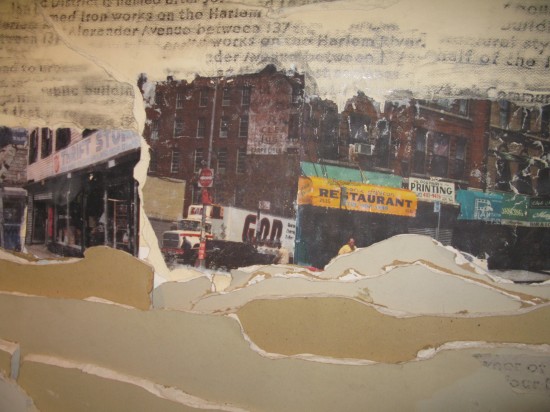
Tourists brave cold to find cutting edge work
Barry Kostrinsky paused near the place where the bond trader Sherman McCoy took a wrong turn to the Bronx and disaster in Bonfire of the Vanities, the Tom Wolfe novel that cemented the South Bronx’s reputation as a terrifying place.
Some people still ask him “whether it’s safe here,” Kostrinsky said. But he wants to polish a new image for Mott Haven, showing it off to curious art lovers who may still be a bit timid about walking the streets alone.
“The Bronx Museum of Art is a big spot, and they pick up artists from this area for their shows,” he boasted, as he contrasted reputation and reality.
On a cold January midday, he met 25 tourists on the corner of Third Avenue and East 138th Street.
“There is a lot of curiosity about this area,” said Mary Kay Judy, a preservation consultant. “It’s a big crowd for a cold day.”
Sponsored by the Municipal Art Society and comprised of society members, the tour included few residents of the Bronx, but all had some ties to the borough, from family history to workplaces.
“My father grew up on the Grand Concourse, and I love to see the Bronx,” said Deborah Abel, a kindergarten teacher. “I’ve seen Melrose, but I’ve never been around here.”
Kostrinsky is a Riverdale resident whose family once owned an upscale silver tableware factory in Mott Haven. Since the closing of his family’s firm, he has found new success in the neighborhood as a promoter for local artists through the Haven Gallery on Bruckner Boulevard.
“Artists started moving here when Brooklyn got too expensive,” said Kostrinsky. “It’s only 15 minutes to 86th Street.”
The first stop was a former warehouse-turned-loft condominiums, where owner Linda Cunningham operates a gallery on the first floor.
Twisted metal beams were arranged as plants on the floor. Nearby, a concrete post that once stood on the border between East and West Germany, takes new life as part of an art installation.
On the wall was a sketch a sketch of a Khmer temple overrun by vegetation. For Cunningham, the crumbling border post and the temple reclaimed by nature symbolize the temporary aspects of an urban landscape.
“Linda is about art as transformation,” said Kostrinsky. “It’s one thing to buy expensive art objects, but she reconstructs objects from the street.”
“This is a garden tended by retired men from the housing project,” said Cunningham, pointing at a photo collage of a street scene. “They guard it, and it’s so sweet.”
Fellow resident Carey Clark once had a studio in Manhattan, but as the neighborhood changed, she sought a more inspiring home. “Tribeca was once arty and funky, but in three weeks the suits moved in,” said Clark.
Since 1990, her murals have spanned the width of the Bronx, from the Yankee Stadium subway station to Hunts Point, where she maintains a framing studio and runs the art program at the local community center, The Point.
“Not all artists have cool-looking art spaces,” said Kostrinsky. “Our next artist lives in a small apartment.”
Jeffrey Acea, 57, who is wheelchair bound, lives in Plaza Boriquen, a low-income cooperative on East 138th Street. Prior to his art career, Acea also claims fame as the city’s first handicapped cab driver.
A self-taught artist, according to Kostrinsky, his current project is a series of scenes from the Third Avenue El, the historic elevated railway that was torn down in 1973. “It created a ghost town along Third Avenue up to Fordham Road,” said Acea.
On the south side of the Major Deegan, the tour group climbed five stories to the apartment-gallery of Luis D. Rosado, 28, where a photography exhibit by George LeGare graces the walls.
“The idea was to create an art space where artists can collaborate in a cohesive way,” said Rosado.
The 25 tour participants barely squeezed into the gallery, as a large printer churned out copies of photographs, and participating artists weaved through the crowd.
“I came from a missionary family, so I’m comfortable opening my door to visitors,” said Rosado. “I’ve had guests from Canada, and they never expected this in the South Bronx.”
